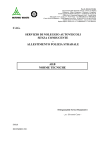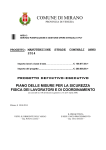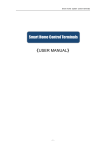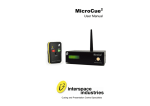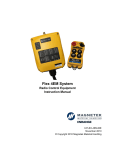Download MANUALE D'USO OPERATING INSTRUCTIONS
Transcript
MANUALE D’USO _________________________ OPERATING INSTRUCTIONS MANUALE D’USO INDICE INDICE.................................................................................................................................................................................... 1 INTRODUZIONE .................................................................................................................................................................... 2 Contenuto dell'imballo ............................................................................................................................................................................... 2 Contenuti di questo manuale..................................................................................................................................................................... 2 Convenzioni tipografiche ........................................................................................................................................................................... 2 DATI DI MARCATURA........................................................................................................................................................... 2 NORME DI SICUREZZA ........................................................................................................................................................ 2 NOTE DI SICUREZZA ED INFORMAZIONI SUPPLEMENTARI .......................................................................................... 3 DESCRIZIONE DEL PRODOTTO ......................................................................................................................................... 4 Esempi di applicazione.............................................................................................................................................................................. 4 Alimentazione............................................................................................................................................................................................ 5 Uso mobile ................................................................................................................................................................................................ 5 Montaggio.................................................................................................................................................................................................. 5 Frequenze operative.................................................................................................................................................................................. 5 INSTALLAZIONE ................................................................................................................................................................... 5 Prerequisiti ................................................................................................................................................................................................ 5 TARATURA CANALI E FREQUENZE ................................................................................................................................... 6 MONTAGGIO DEL TRASMETTITORE E DEL RICEVITORE .............................................................................................. 7 Casi di installazione................................................................................................................................................................................... 8 Montaggio del trasmettitore e del ricevitore........................................................................................................................................... 8 Due collegamenti radio in parallelo usando due frequenze................................................................................................................... 8 Connessioni del trasmettitore e del ricevitore ........................................................................................................................................... 9 SOLUZIONE PROBLEMI..................................................................................................................................................... 10 SPECIFICHE TECNICHE..................................................................................................................................................... 10 Dati sul sistema ....................................................................................................................................................................................... 10 Connessioni del sistema ......................................................................................................................................................................... 10 Dati generali ............................................................................................................................................................................................ 10 Trasmettitore RDDT433 .......................................................................................................................................................................... 11 Ricevitore RDDR433 ............................................................................................................................................................................... 11 Il produttore declina ogni responsabilità per eventuali danni derivanti da un uso improprio delle apparecchiature menzionate in questo manuale; si riserva inoltre il diritto di modificarne il contenuto senza preavviso. Ogni cura é stata posta nella raccolta e nella verifica della documentazione contenuta in questo manuale: tuttavia il produttore non può assumersi alcuna responsabilità derivante dall’utilizzo della stessa. Lo stesso dicasi per ogni persona o società coinvolta nella creazione e nella produzione di questo manuale. Pag. 1 RDDR/RDDT9823/2 INTRODUZIONE Contenuto dell'imballo • 1 trasmettitore o ricevitore • 1 antenna • 1 manuale di istruzioni Dopo la consegna, controllare se il contenuto dell'imballo è danneggiato e controllare eventuali segni o abrasioni. Nel caso contattare immediatamente il fornitore. Controllare che il contenuto corrisponda alla lista del materiale sopra elencata. Contenuti di questo manuale Questo manuale descrive il sistema di trasmissione dati via radio RDDR433 / RDDT433 assieme alle procedure per l'installazione, configurazione e uso. Leggere questo manuale con attenzione, in particolare il capitolo riguardante le norme di sicurezza, prima dell'installazione e dell'uso del sistema. Convenzioni tipografiche In questo manuale vengono utilizzati differenti simboli grafici, il senso di questi simboli è sotto descritto: L'operazione è molto importante per il corretto funzionamento del sistema: leggere attentamente la procedura indicata e seguire le modalità richieste. Descrizione delle caratteristiche del sistema: leggere attentamente per capire le fasi seguenti. Dati di marcatura Sul sistema di trasmissione dati via radio RDDR433 / RDDT433 ci sono due etichette conformi alle specificazioni CE. La prima etichetta include: • Codice identificazione modello (Codice a barre esteso 3/9 ) • Tensione di alimentazione (Volt) • Frequenza(Hertz) • Assorbimento energia (Watt) La seconda etichetta mostra il numero di serie del modello (Codice a barre esteso 3/9) Quando viene installato l’apparecchio, controllare che le specifiche riguardanti l’alimentazione del sistema di trasmissione dati via radio corrispondano a quelle richieste. L’uso improprio può seriamente compromettere la sicurezza del personale addetto e dell’installazione. NORME DI SICUREZZA Il sistema di trasmissione dati via radio RDDR433 / RDDT433 è conforme con le normative di legge in vigore al tempo della stesura di questo manuale, riguardo sicurezza elettrica, compatibilità elettromagnetrica e altri requisiti generali. Si desidera tuttavia garantire gli utilizzatori (tecnico installatore e operatore) specificando alcune avvertenze per operare nella massima sicurezza: • L’installazione dell’apparecchio (e dell’intero impianto di cui esso fa parte) deve essere effettuata da personale tecnico adeguatamente qualificato • L’apparecchio deve essere aperto soltanto da personale tecnico qualificato. La manomissione dell’apparecchio fa decadere i termini di garanzia • Collegare ad una linea di alimentazione corrispondente a quella indicata sulle etichette di marcatura (vedere il successivo capitolo Dati di marcatura) • Prima di spostare o effettuare interventi tecnici sull’apparecchio, disinserire la spina di alimentazione Pag. 2 RDDR/RDDT9823/2 • • • • Non utilizzare l’apparecchio in presenza di sostanze infiammabili Non permettere l’uso dell’apparecchio a bambini o incapaci Accertarsi che l’apparecchio sia fissato in maniera solida e affidabile L’apparecchio si considera disattivato soltanto quando l’alimentazione é disinserita e i cavi di collegamento con altri dispositivi sono stati rimossi • Per l’assistenza tecnica rivolgersi esclusivamente al personale tecnico autorizzato • Conservare con cura il presente manuale per ogni futura consultazione NOTE DI SICUREZZA ED INFORMAZIONI SUPPLEMENTARI Il sistema di trasmissione dati via radio può essere alimentato solo attraverso un alimentatore 12 VDC, il quale deve essere protetto da un fusibile ritardato da 1A . In nessuna circostanza il sistema può essere alimentato direttamente con un cavo di alimentazione (p.e. 230VAC). Ignorare queste note di sicurezza può mettere in pericolo la vostra vita! Una prolungata esposizione degli occhi alle radiazioni emesse dal trasmettitore o dalla sua antenna può essere rischioso ai fini della salute. Il trasmettitore ed il ricevitore possono essere aperti solamente da personale tecnico qualificato. Non applicare etichette adesive, lamine metalliche, pittura o equivalenti coprendo le scatole del trasmettitore e del ricevitore, perché ciò può interferire con il corretto funzionamento del sistema. Pag. 3 RDDR/RDDT9823/2 DESCRIZIONE DEL PRODOTTO Il sistema trasmissione dati via radio è un prodotto tecnicamente molto sviluppato. E’ stato concepito per l’uso nei settori della trasmissione dei segnali e della sicurezza. Nessuna licenza individuale è richiesta per la sua operatività. Esempi di applicazione Il collegamento radio trasmette il segnale dati RS232 senza l'ausilio di fili. Tipiche applicazioni possibili sono: • trasmissione dati di telemetria tra tastiera e ricevitore • trasmissione dati tra tastiera e matrice (con due coppie di dispositivi) • superare ostacoli come fiumi, strade e in tutte quelle applicazioni che rendono difficile l’installazione dei cavi. Pag. 4 RDDR/RDDT9823/2 Alimentazione Il trasmettitore ed il ricevitore operano con un voltaggio di 12VDC. Tale voltaggio può essere fornito da una fonte stabilizzata capace di fornire una corrente continua di almeno 0.3A, per il trasmettitore e per il ricevitore, il circuito di alimentazione deve essere protetto da un fusibile ritardato da 1A . Uso mobile Se, durante l’uso mobile del sistema di trasmissione via radio via radio, nessuna erogazione di corrente è disponibile, il trasmettitore ed il ricevitore possono essere alimentati da una batteria per auto da 12V. Montaggio Una scatola stagna permette ovunque facili installazioni, anche all’esterno, su muri di edifici o su alberi. Frequenze operative La trasmissione dei dati avviene su una frequenza tarata all'interno della gamma compresa tra i 433,875 e i 434,650 MHz, riferendosi al setup del dip-switch interno (vedi tavola a pag. 7). 32 indipendenti frequenze di collegamento sono disponibili. Il trasmettitore ed il ricevitore devono essere tarati con la stessa frequenza. Si prega di notare che i componenti del sistema di collegamento radio non possono essere usati come relay stations. INSTALLAZIONE L’installazione deve essere eseguita solamente da personale tecnicamente qualificato. Le seguenti procedure devono essere eseguite con l’alimentatore spento se non altrimenti specificato. Prerequisiti Per ottenere migliori prestazioni, il sistema deve essere installato in modo che il trasmettitore ed il ricevitore si fronteggino senza ostacoli, cioè non ci devono essere ostacoli statici (linee dell’alta tensione, alberi, muri, edifici, etc.) o dinamici (tramvie, ferrovie, autovie, etc.) tra le due unità. Pag. 5 RDDR/RDDT9823/2 TARATURA CANALI E FREQUENZE Canali Frequenze 4 bits Switch Jumper Canali Frequenze A1 433,875 ON ON ON A2 433,925 ON ON ON A3 433,975 ON ON A4 434,025 ON ON A5 434,075 ON OFF ON A6 434,125 ON OFF ON A7 434,175 ON A8 434,225 A9 4 bits Switch Jumper ON ON B1 433,900 ON ON ON ON OFF OFF ON B2 433,950 ON ON ON OFF OFF OFF ON ON B3 434,000 ON ON OFF ON OFF OFF OFF ON B4 434,050 ON ON OFF OFF OFF ON ON B5 434,100 ON OFF ON ON OFF OFF ON B6 434,150 ON OFF ON OFF OFF OFF OFF ON ON B7 434,200 ON OFF OFF ON OFF ON OFF OFF OFF ON B8 434,250 ON OFF OFF OFF OFF 434,275 ON ON ON ON ON B9 434,300 ON ON ON ON OFF A10 434,325 OFF ON ON OFF ON B10 434,350 OFF ON ON OFF OFF A11 434,375 OFF ON OFF ON ON B11 434,400 OFF ON OFF ON OFF A12 434,425 OFF ON OFF OFF ON B12 434,450 OFF ON OFF OFF OFF A13 434,475 OFF OFF ON ON ON B13 434,500 OFF OFF ON ON OFF A14 434,525 OFF OFF ON OFF ON B14 434,550 OFF OFF ON OFF OFF A15 434,575 OFF OFF OFF ON ON B15 434,600 OFF OFF OFF ON OFF A16 434,625 OFF OFF OFF OFF ON B16 434,650 OFF OFF OFF OFF OFF Sistema taratura frequenze: Gruppo A: Jumper ON Gruppo B: Jumper OFF Switch: ON = “L” OFF = “H” Esempi: Taratura canale A5 (434,075MHz) Gruppo A: Jumper ON Switch: ON, OFF, ON, ON RDDT433 RDDR433 Pag. 6 RDDR/RDDT9823/2 Montaggio del trasmettitore e del ricevitore 1. Scegliere delle posizioni adatte per il trasmettitore ed il ricevitore, tenendo bene a mente i prerequisiti descritti nella sezione relativa. Marcare le posizioni scelte. 2. L’orientamento ideale dell’installazione del trasmettitore e del ricevitore è “orizzontale” (con il cavo sul fondo: vedi l’illustrazione “Esempio di installazione” a pagina 5). 3. Eseguire 4 fori sul muro come mostrato in Fig. A. 4. Avvitare il fondo della scatola come mostrato in Fig. B. 5. Avvitare il coperchio della scatola come mostrato in Fig. C. 6. Dovunque possibile, stendere i cavi di connessione attraverso la muratura; se il trasmettitore o il ricevitore sono montati su di un muro. In tutti i casi, prestare attenzione che i cavi siano adeguatamente protetti da, ad esempio, un condotto. Alternativa Pag. 7 RDDR/RDDT9823/2 Casi di installazione Montaggio del trasmettitore e del ricevitore Trasmettitore Ricevitore La massima distanza che garantisce il funzionamento tra trasmettitore e ricevitore è di 700m. Due collegamenti radio in parallelo usando due frequenze Se si desidera usare due sistemi di trasmissione dati via radio simultaneamente ed in parallelo, un sistema dovrà utilizzare una differente frequenza di comunicazione (sono disponibili fino a 32 diverse frequenze). Pag. 8 RDDR/RDDT9823/2 Connessioni del trasmettitore e del ricevitore • Connettere l’ingresso dati in RS232 al trasmettitore. • Prelevare l’uscita dati in RS232 dal ricevitore. • Connettere il trasmettitore ed il ricevitore a diverse alimentazioni 12VDC (filo bianco al terminale positivo, filo marrone al negativo). Alimentazione (12VDC) RS232 verde (DATA) bianco (GND) marrone (-) marrone (GND) bianco (+) Pag. 9 RDDR/RDDT9823/2 SOLUZIONE PROBLEMI Problemi Il ricevitore non funziona Cause possibili Alimentatore 12VDC per trasmettitore e ricevitore mancante Trasmettitore e ricevitore trasmettono in differenti frequenze Segnale radio (parzialmente) deviato da alberi, edifici, veicoli, etc. Trasmettitore e ricevitore troppo distanti Cavo rotto o tagliato nella connessione con trasmettitore o ricevitore Rimedi Connettere il trasmettitore ed il ricevitore all’alimentatore 12VDC Modificare il trasmettitore o il ricevitore Montare il trasmettitore/ricevitore in una posizione più favorevole (vedi la sezione “Prerequisiti”) Installare il trasmettitore e ricevitore cosicchè la distanza massima tra le due unità non ecceda quanto specificato nella sezione “Dati tecnici” Il cavo difettoso deve essere rimpiazzato dal personale di servizio SPECIFICHE TECNICHE Dati sul sistema Stabilità di frequenza Segnali in ingresso e in uscita Modulazione Comunicazione Tipo ±2 KHz RS232,1200 Baud max. FM stretta Una via PLL synthesizer Connessioni del sistema Connessione cavo “DATI” Connessione cavo“12VDC” lungo 2 m con finali aperti (tre-poli) lungo 2 m con finali aperti (due-poli) Dati generali Temperatura di utilizzo Temperatura di immagazzinamento Umidità relativa Protezione del contenitore Dimensioni del contenitore Lunghezza antenna Peso Pag. 10 -10°C...+60°C -20°C...+65°C Max. 90% IP 54 (protezione contro gli spruzzi d’acqua) 200 mm x 200 mm x 60 mm 170mm 0.4 kg RDDR/RDDT9823/2 Trasmettitore RDDT433 Frequenza standard (nominale) Passo tra i canali Numero di canali Potenza output EIRP Antenna del trasmettitore Apertura angolo dell’antenna Voltaggio dell’alimentazione Massimo assorbimento corrente 434,650 MHz 25 KHz 32 10 mW fissa omnidirezionale 12VDC 50 mA Ricevitore RDDR433 Frequenza standard (nominale) Passo tra i canali Numero di canali Potenza necessaria di ricezione (isotropica) Antenna del ricevitore Apertura angolo dell’antenna Voltaggio dell’alimentazione Massimo assorbimento corrente 434,650 MHz 25 KHz 32 ≥-84 dBm fissa omnidirezionale 12VDC 50 mA QUESTO PRODOTTO È SOLO PER ESPORTAZIONE FUORI DALLA CEE. Pag. 11 RDDR/RDDT9823/2 OPERATING INSTRUCTIONS INDEX INDEX..................................................................................................................................................................................... 1 INTRODUCTION .................................................................................................................................................................... 2 Packing contents ....................................................................................................................................................................................... 2 Contents of this Manual............................................................................................................................................................................. 2 Typographic conventions........................................................................................................................................................................... 2 IDENTIFICATION DATA ........................................................................................................................................................ 2 SAFETY RULES .................................................................................................................................................................... 2 SAFETY NOTES AND ADDITIONAL INFORMATION.......................................................................................................... 3 PRODUCT DESCRIPTION .................................................................................................................................................... 4 Application example .................................................................................................................................................................................. 4 Power supplies .......................................................................................................................................................................................... 5 Mobile use ................................................................................................................................................................................................. 5 Mounting.................................................................................................................................................................................................... 5 Operating frequencies ............................................................................................................................................................................... 5 INSTALLATION ..................................................................................................................................................................... 5 Prerequisites ............................................................................................................................................................................................. 5 CHANNEL AND FREQUENCY SETTING ............................................................................................................................. 6 MOUNTING THE TRANSMITTER AND RECEIVER............................................................................................................. 7 Installation examples................................................................................................................................................................................. 8 Mounting the transmitter and receiver ................................................................................................................................................... 8 Two radio link systems in parallel using two channels .......................................................................................................................... 8 Connecting and aligning the transmitter and receiver ............................................................................................................................... 9 TROUBLE SHOOTING ........................................................................................................................................................ 10 SPECIFICATIONS................................................................................................................................................................ 10 System data ............................................................................................................................................................................................ 10 System connections ................................................................................................................................................................................ 10 General data............................................................................................................................................................................................ 10 Transmitter RDDT433 ............................................................................................................................................................................. 11 Receiver RDDR433 ................................................................................................................................................................................. 11 The manufacturer declines all responsibility for any damage caused by an improper use of the appliances mentioned in this manual; furthermore, the manufacturer reserves the right to modify its contents without any prior notice. The documentation contained in this manual has been collected with great care: the manufacturer, however, cannot take any liability for its use. The same thing can be said for any person or company involved in the creation and production of this manual. Pag. 1 RDDR/RDDT9823/2 INTRODUCTION Packing contents • 1 transmitter or receiver • 1 antenna • 1 instruction manual After the delivery, check that the packing is not damaged and shows no evident signs of falls or abrasion. Should this be so, contact immediately the supplier. Check that the contents correspond to the above-mentioned list of materials. Contents of this Manual This manual describes the data wireless system RDDR433/RDDT433 together with its specific procedures of installation, configuration and use. Read this manual carefully, in particular the chapter concerning the safety rules, before installing and using the wireless system. Typographic conventions Different graphic symbols are used in this manual, the meaning of which is here described: Hazard of electric shock; disconnect the power supply before proceeding, if not otherwise specified. The operation is very important for the correct working of the system: read carefully the procedure indicated, and carry it out according to the required modalities. Description of system features: read carefully to understand the following phases. IDENTIFICATION DATA On the data wireless system RDDR433/RDDT433 there are two plates complying with EC specifications. The first plate includes: • Model identification code (Extended bar code 3/9 ) • Mains voltage (Volt) • Frequency (Hertz) • Power consumption (Watt) The second plate shows the model serial number (Extended bar code 3/9) When installing the appliance, check that the power supply specifications of the data wireless system correspond to those required. The use of improper appliances may seriously compromise the safety of the personnel and the installation. SAFETY RULES The data wireless system RDDR433/RDDT433 complies with the normative laws in force at the time of editing of this manual, concerning electric safety, electromagnetic compatibility and general requirements. Anyway, in order to ensure the users (installer technician and operator), the following warnings are specified for safety’s sake: • Connect to a feeder corresponding to the specifications indicated on the data plate (see next chapter Identification data) • The outlet must be correctly earthed according to the normative laws in force • Before any shifting or technical operations on the appliance, unplug it from the mains • Do not use voltage cables showing wear or ageing, since they may seriously compromise the users’ safety • The appliance (and the complete system, which it belongs to) must be installed only by qualified technical staff • The appliance must be opened only by qualified technical staff. The tampering of the appliance may void the guarantee terms. Pag. 2 RDDR/RDDT9823/2 • • • • Do not use the appliance in the presence of inflammable substances Do not allow children or people not familiar with the appliance to use it Make sure the appliance is fixed in a solid and reliable way The appliance is completely off-line only when the plug is diconnected and the cables connected to other appliances have been removed • For after-sale service call only authorised technical staff. • Keep this manual close to hand for any future reference SAFETY NOTES AND ADDITIONAL INFORMATION 12VDC The data wireless system may be operate only from a 12VDC supply, which must be protected with a 1A slow-blow fuse. Under no circumstances may the system be operated directly from the mains supply (e.g. 230VAC). Ignoring this safety note can endanger your life! 12VDC Furthermore, operation from the mains will cause irreparable damage to the system. Prolonged exposure of the eyes to the radiation emitted by the transmitter or its antenna incurs a healt risk The transmitter and receiver may be opened only by our service and repair personnel. Removing the sealed screws and opening the case will invalidate the warranty. Do not apply adhesive labels, metalfoil, paint or similar coverings to the case of the transmitter or receiver, since this can interfere with the correct operation of the system. Pag. 3 RDDR/RDDT9823/2 PRODUCT DESCRIPTION The data wireless system is a highly developed technical product. It was designed specifically for charge-free use in the sectors of signal transmission and security technology. No individual license is required for operation. Application example The radio link transmit RS232 data signal without wires. Possible typical applications are: • telemetry data transmission among keyboard and receivers • to overcome obstacles such as rivers, roads and all applications which make difficult cables installation. Pag. 4 RDDR/RDDT9823/2 Power supplies The transmitter and receiver operate from a voltage of 12VDC. This can be provided by an stabilized mains adapter capable of supplying a continuos current of at least 0.3A for the transmitter and receiver must be protected by a 1A slow-blow fuse. Mobile use If, during mobile use, no mains voltage is available, the transmitter and receiver can be operated from a 12V car battery. Mounting An easily mounted, weatherproof case permits installation anywhere, even outdoors on building walls or on wooden masts. Operating frequencies Data transmission is performed on a frequency set in the range 433,875- 434,650 MHz,according to the internal dipswitch setup (table page 7). 32 indipendent link frequencies are available. Transmitter and receiver must be set at the same code. Please note that the components of the radio link system cannot be used as relay stations. INSTALLATION The installation must be carried out only by qualified technical staff. The following procedures must be carried out with power supply off, if not otherwise specified. Prerequisites In order to obtain the best performances, the system must be installed such that there is a free line of sight between the transmitter and receiver, i.e. there must be no static (high-tension lines, trees, walls, buildings, etc.) or dynamic (trams, railways, trucks, etc.) obstacles between the two units. Pag. 5 RDDR/RDDT9823/2 CHANNEL AND FREQUENCY SETTING Channel Frequency 4 bits Switch Jumper Channel Frequency A1 433,875 ON ON ON A2 433,925 ON ON ON A3 433,975 ON ON A4 434,025 ON ON A5 434,075 ON OFF ON A6 434,125 ON OFF ON A7 434,175 ON A8 434,225 A9 4 bits Switch Jumper ON ON B1 433,900 ON ON ON ON OFF OFF ON B2 433,950 ON ON ON OFF OFF OFF ON ON B3 434,000 ON ON OFF ON OFF OFF OFF ON B4 434,050 ON ON OFF OFF OFF ON ON B5 434,100 ON OFF ON ON OFF OFF ON B6 434,150 ON OFF ON OFF OFF OFF OFF ON ON B7 434,200 ON OFF OFF ON OFF ON OFF OFF OFF ON B8 434,250 ON OFF OFF OFF OFF 434,275 ON ON ON ON ON B9 434,300 ON ON ON ON OFF A10 434,325 OFF ON ON OFF ON B10 434,350 OFF ON ON OFF OFF A11 434,375 OFF ON OFF ON ON B11 434,400 OFF ON OFF ON OFF A12 434,425 OFF ON OFF OFF ON B12 434,450 OFF ON OFF OFF OFF A13 434,475 OFF OFF ON ON ON B13 434,500 OFF OFF ON ON OFF A14 434,525 OFF OFF ON OFF ON B14 434,550 OFF OFF ON OFF OFF A15 434,575 OFF OFF OFF ON ON B15 434,600 OFF OFF OFF ON OFF A16 434,625 OFF OFF OFF OFF ON B16 434,650 OFF OFF OFF OFF OFF Frequency Setting Method: Group A: Jumper ON Group B: Jumper OFF Switch: ON = “L” OFF = “H” Example: Set to channel A5 (434,075MHz) Group A: Jumper ON Switch: ON, OFF, ON, ON RDDT433 RDDR433 Pag. 6 RDDR/RDDT9823/2 Mounting the transmitter and receiver 1. Locate suitable positions for the transmitter and receiver, bearing the prerequisites mentioned in the previous section in mind. Mark the positions. 2. The ideal installation orientation for the transmitter and receiver is “horizontal” (with the cable at the bottom: see the illustration “Basic version” on page 5.). 3. Make 4 roles on the wall as shown in Fig. A. 4. Screw the rear of the housing as shown in Fig. B. 5. Screw the covering of the housing as shown in Fig. C. 6. Wherever possible, lay the connection cable through the masonry if the transmitter or receiver is mounted on a wall. In all cases, take care that the cable is suitably protected by, for example, a cable duct. Pag. 7 RDDR/RDDT9823/2 Installation examples Mounting the transmitter and receiver The maximum distance between the transmitter and the receiver is 700m. Two radio link systems in parallel using two channels If you wish to use two data wireless system simultaneously and in parallel, then one system must use different communication codes (up to 32 channels). Pag. 8 RDDR/RDDT9823/2 Connecting and aligning the transmitter and receiver • Connect the transmitter and receiver to separate 12VDC supply voltage (white wire to positive terminal, brown wire to negative). • Connect RS232 data input to transmitter • Take RS232 data output from receiver RS232 Power supply (12VDC) green (DATA) white (GND) brown (-) brown (GND) white (+) Pag. 9 RDDR/RDDT9823/2 TROUBLE SHOOTING Problem Receiver does not work properly Possible cause 12VDC supply for transmitter or receiver missing Transmitter and receiver operating on different frequencies Radio signal (partially) blocked by trees, building, vehicles, etc. Transmitter and receiver too far apart Transmitter or receiver connection cable broken or cut Remedy Connect transmitter or receiver to 12VDC supply Have the transmitter or receiver modified Mount the transmitter/receiver in a more favorable position (see the section “Prerequisites”) Install the transmitter and receiver so that the maximum range specified in the “Technical data” is not exceeded Have the defective cable replaced by service personnel SPECIFICATIONS System data Frequency stability Input and Output Signal Modulation Communication Type ±2 KHz RS232,1200 Baud max. FM narrow One way PLL synthesizer System connections Connection cable “DATA” Connection cable “12VDC” 2 m long with open ends (three-pole) 2 m long with open ends (two-pole) General data Ambient temperature Storage temperature Relative humidity Enclosure type Case dimensions Antenna size Weight -10°C...+60°C -20°C...+65°C Max. 90% IP 54 (splashproof) 200 mm x 200 mm x 60 mm 170mm 0.4 kg Pag. 10 RDDR/RDDT9823/2 Transmitter RDDT433 Standard frequency (nominal) Channel step Number of channels Output power EIRP Transmitter antenna Antenna aperture angle Supply voltage Maximum current consumption 434,650 MHz 25 KHz 32 10 mW fix mounted omnidirectional 12VDC 50 mA Standard frequency (nominal) Channel step Number of channels Necessary received power (isotropic) Receiver antenna Antenna aperture angle Supply voltage Maximum current consumption 434,650 MHz 25 MHz 32 ≥-84 dBm fix mounted omnidirectional 12VDC 50 mA Receiver RDDR433 THIS PRODUCT IS ONLY FOR EXPORT OUTSIDE CEE. Pag. 11 RDDR/RDDT9823/2

























